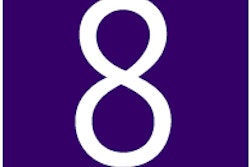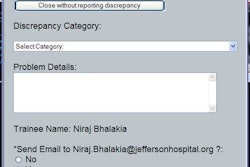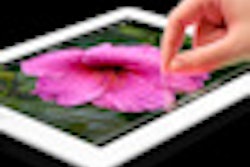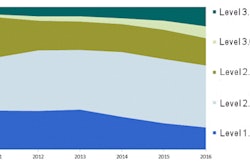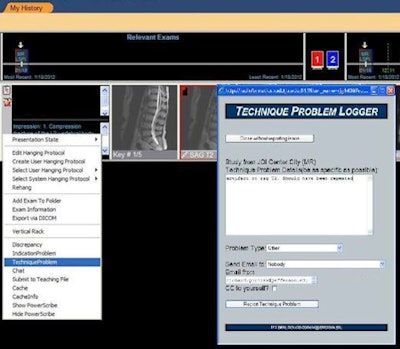
Thomas Jefferson University (TJU) recently experienced a spike in the number of scratches on radiography images at one location. Thanks to an internally developed PACS plug-in called Technique Logger, however, the institution was able to quickly diagnose the problem: faulty equipment maintenance.
In addition to quick spotting of quality control (QC) issues like this one, Technique Logger has definitely improved communication between radiologists and technologists, said Dr. Richard Gorniak. He discussed the software during a presentation at the American Roentgen Ray Society (ARRS) meeting in Vancouver.
Technique Logger is a two-part PACS plug-in: The first component is an integrated PACS tool that enables radiologists to designate and report imaging studies with QC issues, while the second component enables the lead technologist, radiologist, or administrator to see a sortable list of QC cases.
"Technique Logger is quick and easy for radiologists to use, improves technologist-radiologist communication, and documents and tracks QC issues, enabling better QC management," he said.
It's based on the same framework as Discrepancy Logger, another PACS plug-in developed by TJU for logging and communicating discrepancies between on-call resident preliminary reports and final reports from attending radiologists. Both plug-ins are used with the institution's iSite PACS software (Philips Healthcare).
The TJU team was motivated to develop Technique Logger due to frustration at the workflow disruption caused by traditional QC methods of phone or email, Gorniak told AuntMinnie.com.
Communicating QC issues via the phone is disruptive to both radiologists and technologists and does not provide any documentation, Gorniak said. In addition, the technologist who receives the call might not be the same one who performed the exam. Using email also disrupts radiologist workflow and can be time consuming.
With Technique Logger, however, problem cases can quickly be designated with minimal interruption to radiologist workflow, Gorniak said. The lead technologist can then access the QC list to view and track QC cases by site and modality.
After a QC issue is identified from within the PACS application, the radiologist is able to open Technique Logger and provide a description of the issue, which is stored in a database along with automatically extracted case data such as accession number, modality, and performing location.
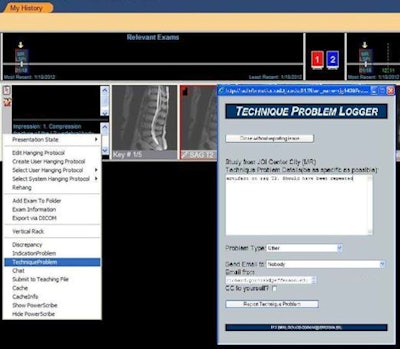 |
| Screenshot of Technique Logger. Image courtesy of Dr. Richard Gorniak. |
This information can also be emailed to the lead technologist from the site in question from within the tool, Gorniak said.
"The radiologist can also designate a case as a 'good job' to acknowledge exceptional tech performance," he said.
The whole process takes less than a minute for the radiologist, and there's no need to switch to another system or application.
A sortable list of QC cases as well as images can be viewed by the lead technologist, radiologist, or administrator via the second component of Technique Logger. Cases can be sorted by modality, location, and category.
"Within this tool, the lead tech can also log their corrective steps and email this to the radiologist who entered the QC issue," he said. "The lead techs can also use this as a teaching resource during tech conferences, showing a group of techs the images from cases entered in the QC database."
Furthermore, the tool can generate enterprise-wide and site-specific statistics for the number of QC issues entered over time by category, Gorniak said. These capabilities were instrumental in detecting the recurrent scratches on radiograph images found at one TJU site. After determining that the issue was due to faulty equipment maintenance, TJU was able to quickly fix the problem.
Technique Logger has definitely improved technologist-radiologist communication, he said. During testing of the plug-in between November 1, 2008, and December 31, 2010, 810 QC cases were reported for an average of about one case per day. After Technique Logger was adopted department-wide on January 1, 2011, 2,332 problem cases and 439 "good jobs" were reported for approximately 6.5 cases per day.
It's used by 90 different radiologists, including attending physicians, fellows, and residents. Gorniak noted that technologist managers and front-line technologists have been responsive to the project. In addition, Pete Natale, chief technologist at TJU, was instrumental in developing Technique Logger, he said.
"However, it should be emphasized that the tool is only as good as the people using it," Gorniak said. "While the Technique Logger can serve as the basis for improving image QC, effort by both techs and radiologists is needed to correct the QC issues detected by this process."




